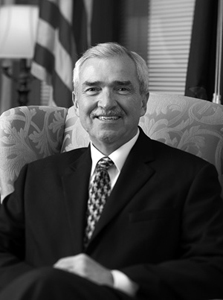MESSAGE FROM THE MAYOR

MAYOR HENRY ANNOUNCES TWO COLLABORATIVE INITIATIVES TO BENEFIT COMMUNITY
Community Development Block Grants give local control for federal funds, Complete Count Committee to work toward full participation in 2010 census
I recently had the opportunity to announce two important community initiatives that will have long-term benefits: the 2009 Community Development Block Grant recipients and the City of Fort Wayne’s 2010 Census Complete Count Committee.
Community Development Block Grants
Nearly 25 programs from about 20 organizations received a portion of $235,000 block grants for public services. Grants ranged from $7,000 to $17,000. CDBG funds for public services have been prioritized for the community’s greatest needs. The many agencies and organizations capably working to address the most pressing concerns said these grants will help support and maintain programs that lift up and assist senior citizens, low-income families, refugees, and those needing job training or health services.
The Community Development Block Grant program is one of the few examples of federal money coming into our community where local decisions affect its use. A group of citizen advisers helps me set the priority for how the funds will be allocated and what challenges will be addressed with this funding. In this time of increasing need and decreasing resources, we strive to distribute the funds in such a way that we make each dollar go as far as it can.
The City receives CDBG funds annually from the U.S. Department of Housing and Urban Development. The amount is based on a formula taking into account many factors, including population and other characteristics. In 2009 the City is receiving $2,132,451. This is the first time since 2003 that Fort Wayne has not experienced a cut in CDBG funds.
Each year the City takes applications from local non-profit organizations for funding social service programs. The City receives anywhere between 30 and 50 applications annually. Funding decisions are made based on a needs assessment and public community meetings completed as part of the five-year Consolidated Plan, which identifies what services the community needs and places a priority on those services.
2010 Census Complete Count Committee:
Last month I welcomed the City’s 2010 Census Complete Count Committee as they started their work today to encourage all Fort Wayne residents to complete the 10-question census form that will arrive in mailboxes next year.
A voluntary committee, the nearly 20 members will work with difficult-to-enumerate populations with the message that the decennial headcount is important and safe. Fort Wayne’s Complete Count Committee will supplement the Census Bureau’s advertising efforts by using members’ local connections of neighbor informing neighbor to result in every person being counted.
The U.S. Census is not only an important tool for demographics, but it is also critical for determining grants and funding for federal programs at the local level. For each person who is not counted, that is much-needed money for health and human service programs, job training, Title 1 education programs, transportation funding, agricultural grants and Housing and Urban Development grants that will not come to Fort Wayne.
The committee will not go door-to-door for people who do not complete the census form; that is the responsibility of Census employees. Instead, committee members will use outreach strategies to increase the number of people who complete the questionnaire.
According to the U.S. Census Bureau, groups most likely to be undercounted are:
Minorities
Children
People below poverty
Immigrants and refugees
People living in large urban areas or rural areas
Under federal law, all responses to census questionnaires are private and strictly confidential. The President and all federal, state and local agencies – including Immigration and Customs Enforcement, Internal Revenue Service, Welfare and law enforcement entities – do not have access to census responses.
The Census Monitoring Board estimated Census 2000 undercounted about 47,000 people in Indiana with an undercount rate of 0.77 percent. Of those not counted, the board calculated 40 percent of them were under age 18 for an undercount rate of 1.15 percent for children.
In addition to federal funding, census numbers apportion the number of Congressional districts for each state, which also results in the number of seats Indiana has in the Electoral College for presidential elections.
- Celebrating 20 Years Of Community At The Stand - April 12, 2024
- First Positive Case Of Chronic Wasting Disease In Indiana - April 12, 2024
- Southwest Allen County Schools Embark On Major Tree Plantings - April 12, 2024


